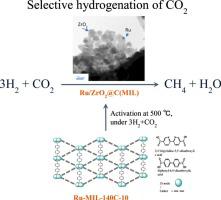Catalysis Today ( IF 5.2 ) Pub Date : 2020-09-07 , DOI: 10.1016/j.cattod.2020.07.080 Dalal S. Alqarni , Chul Wee Lee , Gregory P. Knowles , Christian Vogt , Marc Marshall , Thomas R. Gengenbach , Alan L. Chaffee

|
A novel material, designated Ru/ZrO2@C(MIL), was prepared by thermal transformation of metal organic framework (MOF), MIL-140C-10, in which 10 % of the conventional biphenyl-dicarboxylate linkers had been substituted with bipyridyl-dicarboxylate linkers, thereby providing sites for Ru coordination with the framework. This MOF precursor was compositionally and morphologically transformed when heated, at 500 °C, in a mixture of H2 and CO2 (3:1). The transformation afforded a high surface area product (114 m2/g) with exceptional stability and high Ru metal dispersion which was very effective as catalyst for the hydrogenation of CO2 to CH4, giving a CH4 production of 53 mol/g Ru/h (at 350 °C, 40 bar and WHSV 344 L/h/g cat.). TEM results show that the active form of the catalyst was a partially degraded (‘unzipped’) MOF structure where Ru° and ZrO2 nanoparticles (2−5 and 10−20 nm diameter, respectively) were dispersed upon carbonaceous ribbons.
中文翻译:

源自MIL140C的Ru-氧化锆催化剂,用于将二氧化碳转化为甲烷
通过金属有机骨架(MOF)MIL-140C-10的热转化制备了一种命名为Ru / ZrO 2 @C(MIL)的新型材料,其中10%的常规联苯二羧酸酯连接基已被联吡啶取代-二羧酸酯连接基,从而提供用于Ru与框架配位的位点。当在500°C下于H 2和CO 2(3:1)的混合物中加热时,该MOF前体会发生成分和形态上的转变。该转变提供具有高稳定性的高表面积产物(114m 2 / g)和高Ru金属分散体,这对于将CO 2加氢成CH 4,产生CH 4而言是非常有效的催化剂。生产量为53 mol / g Ru / h(在350°C,40 bar和WHSV 344 L / h / g cat。下)。TEM结果表明,催化剂的活性形式为部分降解(“未压缩”)的MOF结构,其中Ru°和ZrO 2纳米粒子(分别为2-5和10-20 nm直径)分散在碳带上。











































 京公网安备 11010802027423号
京公网安备 11010802027423号